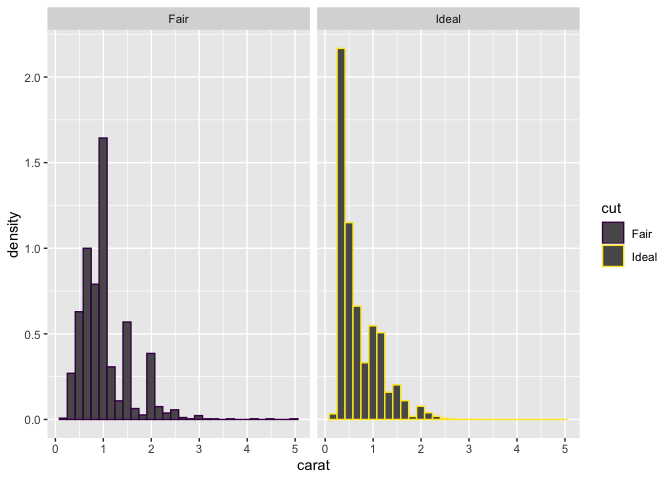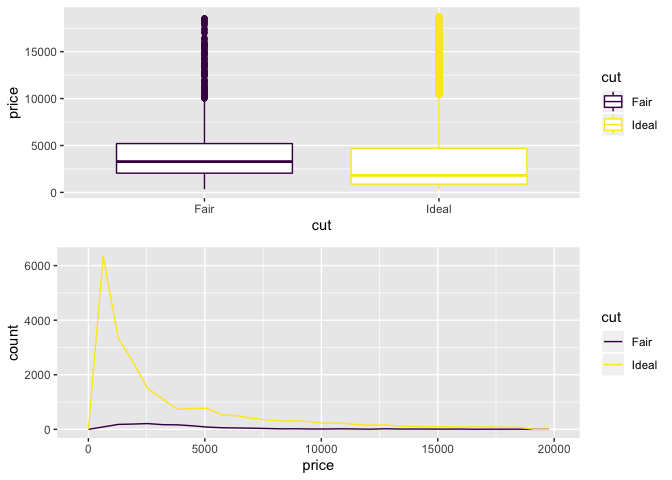Hi,
I don't understand what's wrong with the cohen.d() function to calculate the effect size. Running the function on a different data frame runs OK, there seems to be a problem with the factor levels. The output of the function suggest there's more than 2 levels in the "cut" factor variable, but there's only 2!
Any help on this?
Thanks!
Ramon
code:
#create subset dataframe
library(tidyverse)
diamonds= as.data.frame(diamonds)
diamonds_1= diamonds %>% filter(cut== "Ideal" | cut=="Fair")
#check model assumptions
#normality
ggplot(diamonds_1, aes(carat)) + geom_histogram(aes(y=..density.., color=cut)) + facet_grid(.~ cut)
#> `stat_bin()` using `bins = 30`. Pick better value with `binwidth`.

#normality is not present, but having such a big sample
#size we can apply the central limit theorem and run the test anyway
#assumptions homogeneity of variance
library(gridExtra)
#>
#> Attaching package: 'gridExtra'
#> The following object is masked from 'package:dplyr':
#>
#> combine
box_plot=ggplot(diamonds_1, aes(cut, price)) + geom_boxplot(aes(color=cut))
freq_poly=ggplot(diamonds_1, aes(price)) + geom_freqpoly(aes(color=cut))
grid.arrange(box_plot, freq_poly)
#> `stat_bin()` using `bins = 30`. Pick better value with `binwidth`.

fligner.test(price ~ cut, data = diamonds_1)
#>
#> Fligner-Killeen test of homogeneity of variances
#>
#> data: price by cut
#> Fligner-Killeen:med chi-squared = 7.5966, df = 1, p-value = 0.005848
#scatter on both groups seems bordelinish, depends on the significance level. we can run a test to verify this
t.test(diamonds_1[diamonds_1$cut=="Ideal", "price"], y=diamonds_1[diamonds_1$cut=="Fair", "price"], alternative = "two.sided", conf.level = 0.95, var.equal = TRUE)
#>
#> Two Sample t-test
#>
#> data: diamonds_1[diamonds_1$cut == "Ideal", "price"] and diamonds_1[diamonds_1$cut == "Fair", "price"]
#> t = -9.1995, df = 23159, p-value < 2.2e-16
#> alternative hypothesis: true difference in means is not equal to 0
#> 95 percent confidence interval:
#> -1093.2312 -709.2004
#> sample estimates:
#> mean of x mean of y
#> 3457.542 4358.758
t.test(diamonds_1[diamonds_1$cut=="Ideal", "price"], y=diamonds_1[diamonds_1$cut=="Fair", "price"], alternative = "two.sided", conf.level = 0.95, var.equal = FALSE)
#>
#> Welch Two Sample t-test
#>
#> data: diamonds_1[diamonds_1$cut == "Ideal", "price"] and diamonds_1[diamonds_1$cut == "Fair", "price"]
#> t = -9.7484, df = 1894.8, p-value < 2.2e-16
#> alternative hypothesis: true difference in means is not equal to 0
#> 95 percent confidence interval:
#> -1082.5251 -719.9065
#> sample estimates:
#> mean of x mean of y
#> 3457.542 4358.758
#both seem highly significant, indicating that the difference in the mean between the two groups is not due to chance
#calculating effect size
library(effsize)
cohen.d(formula= price ~ cut, data=diamonds_1, paired = FALSE)
#> Warning in cohen.d.default(d, f, ...): Factor with multiple levles, using only
#> the two actually present in data
#>
#> Cohen's d
#>
#> d estimate: NaN (NA)
#> 95 percent confidence interval:
#> lower upper
#> NaN NaN
Created on 2020-01-13 by the reprex package (v0.3.0)